
About UsThe Numismatic Bibliomania Society is a non-profit organization promoting numismatic literature. For more information please see our web site at coinbooks.org SubscriptionsThose wishing to become new E-Sylum subscribers (or wishing to Unsubscribe) can go to the following web page link MembershipThere is a membership application available on the web site Membership Application To join, print the application and return it with your check to the address printed on the application. Membership is only $20 to addresses in the U.S., $25 for First Class mail, and $30 elsewhere. For those without web access, write to: David M. Sundman, Treasurer AsylumFor Asylum mailing address changes and other membership questions, contact David at this email address: dsundman@LittletonCoin.com SubmissionsTo submit items for publication in The E-Sylum, just Reply to this message, or write to the Editor at this address: whomren@gmail.com
BUY THE BOOK BEFORE THE COIN |
- WAYNE'S WORDS: THE E-SYLUM JULY 13, 2014
- NBS GENERAL MEETING TO BE HELD AUGUST 8, 2014
- SECOND STORY BOOKS OFFERS JOHN HUFFMAN LIBRARY
- NEW BOOK: RBW COLLECTION OF ROMAN REPUBLICAN COINS
- NEW BOOK: AUTHORITATIVE REFERENCE ON MERCURY DIMES
- NEW BOOK: AUTHORITATIVE REFERENCE ON LIBERTY SEATED HALF DIMES
- NEW BOOK: EARLY U.S. QUARTERS PRICES REALIZED 5TH ED.
- QUERY: PHOTOS OF DICK DOTY SOUGHT
- QUERY: CIVIL WAR SUTLER TOKEN INFORMATION SOUGHT
- THE BALDENHOFER-NORWEB 1797 HALF DOLLAR
- Q. DAVID BOWERS, 'DEAN OF AMERICAN NUMISMATICS'
- NOTES FROM E-SYLUM READERS: JULY 13, 2014
- COINS OF SOUTH AMERICA FROM THE LISSNER COLLECTION
- LES CITROME ON DIGITIZING A PROFESSIONAL LIBRARY
- WAYNE'S NUMISMATIC DIARY: JULY 13, 2014
- 2014 ANA NUMISMATIC HALL OF FAME INDUCTEES
- ED MOY ON SAVING BITCOIN FROM THE REGULATORS
- READER OPINIONS ON THE 1863 CSA INGOTS
- WILL NANOTECHNOLOGY ENABLE PERFECT NUMISMATIC FAKES?
- JUDGE RULES FOR ODYSSEY SS CENTRAL AMERICA GROUP
- ARTICLE HIGHLIGHTS TREASURE SALVAGE FINANCES
- DOVEDALE COIN CAVE FIND REPORTED
- ANS LAUNCHES NEW BIOGRAPHIES SITE
- THE DEATH OF THE AUTOGRAPH?
- RUSSIAN LAWMAKER WANTS APOLLO'S GENITALS REMOVED
- FEATURED WEB PAGE: BYRON REED COLLECTION
Click here to access the complete archive
To comment or submit articles, reply to whomren@gmail.com
WAYNE'S WORDS: THE E-SYLUM JULY 13, 2014

VACATION TIME! I'm travelling with my family for a summer vacation. Send me email as usual, but it may take some time before I'm able to reply.
This week we open with more information on the NBS events at the upcoming ANA convention, a price list of books from the John Huffman library, and four new numismatic titles. Other topics include Smithsonian Curator Dick Doty, digitization, and 1863 CSA ingots.
To learn more about the RBW Collection of Roman Republican Coins, the Peter Getz Washington medal die, the Baldenhofer-Norweb 1797 Half Dollar, book guillotines, and Apollo's genitals, read on. Have a great week, everyone!
Wayne Homren
Editor, The E-Sylum

NBS GENERAL MEETING TO BE HELD AUGUST 8, 2014
Numismatic Bibliomania Society General Meeting
Friday, Aug. 8
11:30 a.m.-1 p.m.
Room 42
Donald E. Stephens Convention Center
Dan Hamelberg
Foundational Documents of the U.S. Mint
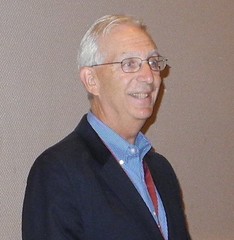 NBS Past President Dan Hamelberg is a longtime U.S. coin collector and numismatic bibliophile, whose personal library of some 15,000 volumes includes some of the rarest specimens of U.S. numismatic literature. He will discuss and display a few highlights of his library, including Thomas Jefferson’s work on weights, measures, and coins, the Congressional Act creating the Mint, and papers appointing Henry Voigt as the first coiner to the U.S. Mint. The latter two documents are both signed by Thomas Jefferson.
NBS Past President Dan Hamelberg is a longtime U.S. coin collector and numismatic bibliophile, whose personal library of some 15,000 volumes includes some of the rarest specimens of U.S. numismatic literature. He will discuss and display a few highlights of his library, including Thomas Jefferson’s work on weights, measures, and coins, the Congressional Act creating the Mint, and papers appointing Henry Voigt as the first coiner to the U.S. Mint. The latter two documents are both signed by Thomas Jefferson.
Wayne Homren
The Past, Present and Future of Online Numismatics
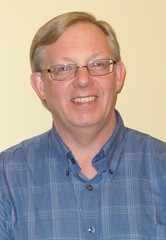 Wayne Homren is founder and editor of The E-Sylum, the weekly NBS electronic newsletter for numismatic bibliophiles, researchers and “just plain collectors”. Covering topics all over the numismatic map from book reviews, hobby history and recent coin designs, its readership spans an engaged and influential global audience, including top authors, collectors and dealers on six continents. For his work Homren won the 2008 Burnett Anderson Memorial Award for numismatic writing.
Wayne Homren is founder and editor of The E-Sylum, the weekly NBS electronic newsletter for numismatic bibliophiles, researchers and “just plain collectors”. Covering topics all over the numismatic map from book reviews, hobby history and recent coin designs, its readership spans an engaged and influential global audience, including top authors, collectors and dealers on six continents. For his work Homren won the 2008 Burnett Anderson Memorial Award for numismatic writing.
Having worked in the technology field his entire career, Homren has been in the vanguard of applying new technologies to his numismatic hobby. “He was writing a blog before the word was coined,” said NBS Historian Joel Orosz. He created NBS’ first web site by hand in the mid-1990s, and led its upgrade in 2008. The site includes a free archive of all E-Sylum issues, encompassing over 17,000 articles to date.
His talk will summarize the history of numismatics on the Internet from the early days of dialup through today’s mobile app-drive world, and looks beyond today to a world where ever more numismatic information is instantly findable and seamlessly usable online.
For more information, see: www.coinbooks.org/events/
SECOND STORY BOOKS OFFERS JOHN HUFFMAN LIBRARY
Second Story Books in the Washington, D.C. metropolitan area is one of the largest used and rare bookstores in the world. Second Story recently acquired the numismatic library of the late John Huffman and has been offering the books online and in their stores.
Kim Stypeck of Second Story forwarded these images and has placed in ad in The E-Sylum. Thanks!
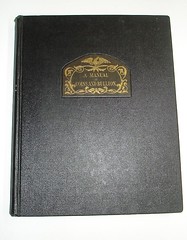
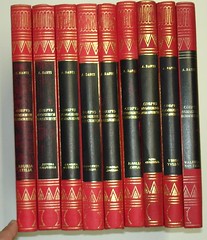
There are over 900 listings, including such titles as:
- Banti, A. and L. Simonetti, Corpus Nummorum Romanorum [18 Volumes Complete]
- Markov, A., Inventory Catalog of the Muslim Coins of the Imperial Hermitage [Two Volumes]
- Mattingly, Harold, et al., The Roman Imperial Coinage
- Lafaurie, Jean, Les Monnaies Des Rois De France
- [Various Editors/Contributors], Sylloge Nummorum Graecorum: The Collection of The American Numismatic Society [Parts 1-9 In Nine Volumes]
- Eckfeldt, Jacob R. and Du Bois, William E., A Manual of Gold and Silver Coins of All Nations
- Banti, Alberto, Corpus Nummorum Romanorum: Monetazione Republicana [Nine Volumes]
- Wiley, Randy and Bill Bugert, The Complete Guide to Liberty Seated Half Dollars
- Lockhart, Sir James H. Stewart, The Stewart Lockhart Collection of Chinese Copper Coins [Royal Asiatic Society, North China Branch Extra Volume --- No. 1]
To view the Huffman library listings, see: www.secondstorybooks.com/searchResults.php?category_id=424&action=browse&browseLetter=A&orderBy=author
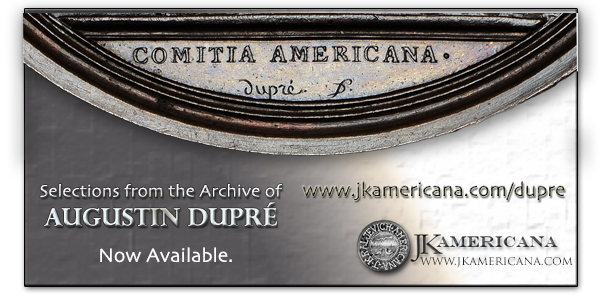
NEW BOOK: RBW COLLECTION OF ROMAN REPUBLICAN COINS
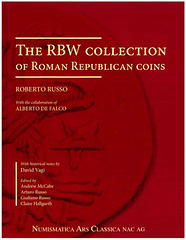 The RBW Collection of Roman Republican Coins
The RBW Collection of Roman Republican Coins
By Roberto Russo, with collaboration of Alberto de Falco
(Numismatica Ars Classica NAC AG 2013)
With historical notes by David Vagi
Edited by Andrew McCabe, Arturo Russo, Giuliano Russo, Claire Hallgarth
Hardcover, 432 pp.
Color illustrations throughout ISBN: 978-88-7794-835-9
Numismatica Ars Classica AG 2013 Zurick
This volume is a record of the RBW Collection of Roman Republican Coins, as they were auctioned in three separate sales: the Triton III sale of December 1999, where the bulk of the gold coins were sold; and the Numismatica Ars Classica Sales 61 (October, 2011) and 63 (May, 2012), where the bronze, silver, and the remainder of the gold was sold.
Price: US$150.00 (no member discount)
For more information, or to order, see: The RBW Collection of Roman Republican Coins (numismatics.org/Store/RBWcollection)
NEW BOOK: AUTHORITATIVE REFERENCE ON MERCURY DIMES
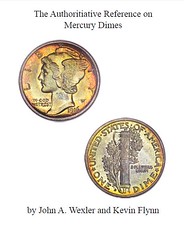 The Authoritative Reference on Mercury Dimes by Kevin Flynn and John Wexler is going to print now, and should be ready in the beginning of August. The book is 8 ½ by 11, 245 pages, softcover only. Retail is $39.95 plus shipping.
The Authoritative Reference on Mercury Dimes by Kevin Flynn and John Wexler is going to print now, and should be ready in the beginning of August. The book is 8 ½ by 11, 245 pages, softcover only. Retail is $39.95 plus shipping.
This book is being be published by Kyle Vick at Stanton Books. For dealer discounts for multiple copies, contact Kyle when the book is printed at (770) 640-5055.
The primary purpose of this book was to create a complete and comprehensive reference for the Mercury dime series including all die varieties, history, patterns, authentication of rare dates, date-by-date analysis, and historical documents.
In 1999, the authors published Treasure Hunting Mercury Dimes, which contained 59 doubled dies and 50 repunched mint marks (RPM). This book contains 64 doubled dies and 105 repunched mint marks. Only a few new doubled dies were added, but the number of RPMs was easily doubled. For each die variety listed, detailed macro photos make identification much easier. Most of the varieties include multiple photographs showing different details. Included also for each variety is a detailed description of the variety, diagnostics, including die markers such as die cracks, scratches, clashes which can make identifying the variety easier, pricing, and cross references.
Many archive letters were uncovered relative to the Mercury dimes and are included. This greatly helped in the analysis of the history section, especially for why the designs were chosen. A section is included on the sculptor the Mercury dime and an analysis of where he most likely chose the image for the obverse from.
The date-by-date section offers an analysis of each date including scarcity, striking characteristics, world history which occurred that year, hot topics, comments, current values, and the certified population counts from PCGS and NGC. This was done for both the coins struck for circulation and the proofs. An additional section describes the differences in the striking characteristics of the bands on the reverse, and shows examples of the different classifications.
An important addition to this book is an authentication section. There are several rare and expensive coins in the Mercury dime series, such as the 1916-D, 1921, 1921-D, 1942/1, and 1942/1-D. There have been many counterfeits generated over the years for this coins. This section provides detailed photographs of genuine coins, and presents die stages for many of these to help in identification. A section was also included on the patterns for the Mercury dime with a detailed description and analysis of each and including a new pattern never before published.
Retail for the softcover is $39.95. Prepublication is available until the book is printed and is $35.95 plus $5 for media shipping or $10 for first class shipping. To reserve your book at the prepublication price, send a check or money order to Kevin Flynn, P.O. Box 396, Lumberton, NJ 08048. Please email me at kevinjflynn88@yahoo.com to reserve a copy. See other books available at www.kevinjflynn.com.
NEW BOOK: AUTHORITATIVE REFERENCE ON LIBERTY SEATED HALF DIMES
The Authoritative Reference on Liberty Seated Half Dimes book by Kevin Flynn should be done in September. This book is being self-published, with only a limited number being printed. The book is 8 ½ by 11, 211 pages. Softcover $39.95 plus shipping.
The primary purpose of this book was to create a complete and comprehensive reference for the Liberty Seated Half Dimes series including all die varieties, history, hub changes, historical documents, and hot topics. The die variety section of the book includes seven 1838-39 doubled stars, five doubled dies, eleven misplaced dates, thirty-five repunched date, and a complete analysis of the overdates, several of which were refuted.
For each die variety listed, detailed macro photos make identification much easier. Most of the varieties include multiple photographs showing different details. Included also for each variety is a detailed description of the variety, diagnostics, including die markers such as die cracks, scratches, clashes which can make identifying the variety easier, pricing, and cross references.
A complete analysis was done on the design changes made in the Liberty Seated half-dime series, and for some showing detailed photos of the differences. A analysis was also done on date and mint mark changes that occurred within a single year.
The archive letters and the history section in the beginning of the book are the same as presented in the book, The Authoritative Reference on Liberty Seated Dollars. As these series were produced in parallel, it was decided to include all of the information for all of the Liberty Seated series for this time period to show what decisions and actions occurred concurrently. In addition, it is important that each book on each series is complete, and not require a different book for reference.
The Hot Topics section contains a several detailed studies on the Liberty Seated half-dime series including an analysis of: the stars used on the 1839 and 1839; the large and small stars used in 1838; refuted overdates; 1840-O transitional reverse; 1860 transitional obverse and reverse; 1870-S; early Liberty Seated proofs; an Liberty Seated certified proofs. The last two sections are the same as in the Liberty Seated Dollar book.
Price for the softcover is $39.95. To order, send a check or money order to Kevin Flynn, P.O. Box 396, Lumberton, NJ 08048. Please include $5 for media shipping or $10 for first class shipping. Please email me at kevinjflynn88@yahoo.com to reserve a copy. See other books available at www.kevinjflynn.com.
NEW BOOK: EARLY U.S. QUARTERS PRICES REALIZED 5TH ED.
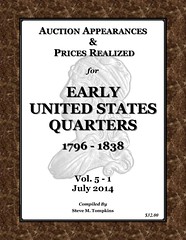 Auction Appearances & Prices Realized
Auction Appearances & Prices Realized
for Early United States Quarters 1796 - 1838
Vol.5-1
By Steve M. Tompkins
NOW TAKING PRE-ORDERS!!!
The 5th edition of Auction Appearances & Prices Realized for Early United States Quarters 1796 - 1838 or the AAPR is at the printer! They should be ready just prior to the ANA.
This compilation encompasses over 6000 auction listings and almost 200 pages, from over 10 years of study and research, and up to 20 years of statistical information relating to the individual die marriages found in the Bust Quarter series.
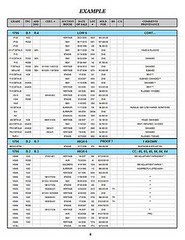 You will also find a listing of the grading service and the unique serial number given to each coin when available, as well as die stage information and cataloger comments. All grades from all die marriages of the Bust Quarter series from 1796 to 1838 are included in this list.
You will also find a listing of the grading service and the unique serial number given to each coin when available, as well as die stage information and cataloger comments. All grades from all die marriages of the Bust Quarter series from 1796 to 1838 are included in this list.
Some of the benefits include: Tracking pedigrees and price fluctuations. An updated condition census for each marriage. See rarities of both the whole die marriage and grade rarities within each die marriage. Track the price differences of NGC & PCGS, as well as the addition of a CAC sticker. All for less than a tank of gas!
$35.00 delivered...
To order, please send payments to:
Steve Tompkins
P.O. Box 844
Peculiar, Mo. 64078
Or feel free to e-mail any questions to: smt115@aol.com
QUERY: PHOTOS OF DICK DOTY SOUGHT
In a recent email conversation with Richard Doty’s widow, Cindi Roden Doty, she opined, “I'm sure lots of people have good pictures of him; I wish they would all send me what they have.”
I had emailed Cindi the attached photo of Dick, which I found while searching through my files. I think it’s a great portrait of the good doctor: always the scholar and student of numismatics, but with a fun side as demonstrated by his relaxed attire! This was taken by Dave Bowers during a July 2010 visit to the Smithsonian; Dave, David Sundman, and I went into the archives of the National Numismatic Collection with two research assistants to begin scanning bank notes for the massive project that would eventually become the Whitman Encyclopedia of Obsolete Paper Money.
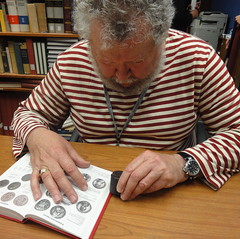 Dick was our gracious host during that visit. I remember walking into the NNC offices and there he was, loupe in hand, huddled over an old copy of the Red Book, comparing a Peter Getz Washington medal die to its illustration. He spoke enthusiastically about his research for a few minutes, and his excitement was contagious!
Dick was our gracious host during that visit. I remember walking into the NNC offices and there he was, loupe in hand, huddled over an old copy of the Red Book, comparing a Peter Getz Washington medal die to its illustration. He spoke enthusiastically about his research for a few minutes, and his excitement was contagious!
On Cindi’s behalf and with her permission, I’d like to invite readers of The E-Sylum to email her any photos they might have of Dick Doty. Her email address is rodenc@verizon.net. I know there are a lot of shutterbugs in the hobby community, and Dick was always here, there, and everywhere, so I’m sure there are photos that she’s never seen, and would enjoy adding to her memory book.
QUERY: CIVIL WAR SUTLER TOKEN INFORMATION SOUGHT
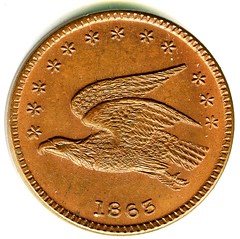
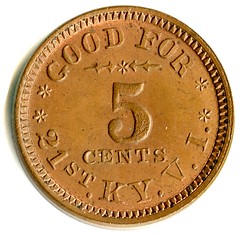
Dave Bowers writes:
For a Whitman project I am compiling information on Civil War sutler tokens issued by licensed vendors who usually traveled with the troops. This will be a short study, perhaps a couple dozen or so pages as a synopsis, building on the work of David Schenkman, with his advice and consent, and also with a nod to the in-depth study now being prepared by Richard Irons. I seek this information:
- Does anyone have a cross-reference matching certain sutler dies with Civil War token dies?
- Has anyone identified the geographical locations of certain sutlers called NL (Non-Local) by Dave Schenkman?
- Does anyone have any new varieties?
I welcome hearing from anyone with such information. All good wishes,
Dave Bowers
qdbarchive@metrocast.net
THE BOOK BAZARRE
THE BALDENHOFER-NORWEB 1797 HALF DOLLAR
Greg Reynolds writes:
My current article may be of particular interest to you and to the readers of The E-Sylum. Yes, I realize that most of your readers may not care about the fact that the Norweb 1797 half will be auctioned at the upcoming ANA Convention. This coin, however, was previously in the Stack’s sale of the “Farish Baldenhofer Collection” in 1955.
I devote a large section of this article to a discussion of that sale. I repeatedly and mostly favorably cite an article on Baldenhofer, which was written by W. David Perkins and published in The Asylum in 2007. I disagree with Perkins’ approach to interpreting that auction. Indeed, I put forth my own hypothesis regarding this 1797 half and the Baldenhofer consignment, which is supported by information found by Perkins, by evidence I found myself, and by my prior knowledge of the history of coin auctions. The Baldenhofer Collection and this specific auction in 1955 are of great importance, much more so than readers of Perkins’ article may realize.


The Norweb 1797 Draped Bust, Small Eagle Half Dollar is, indisputably, the second finest known 1797 half dollar. It is certainly among the five finest coins of the entire Draped Bust, Small Eagle design type of half dollars. The Norweb 1797 will be auctioned in August by Heritage at the ANA Convention near Chicago.
This 1797 half was previously in two auctions of great importance. The first epic auction that I ever attended was the Norweb III sale in Nov. 1988. This half dollar was one of the highlights. I now remember being stunned by it. I was startled that it even existed. No one I knew then had knowledge of the superior Rogers 1797, except Ed Milas who had yet to tell me about the Rogers 1797. Many experts were then under the impression that a MS-64+ or higher grade 1797 half did not exist!
The Norweb 1797 was the best 1796 or 1797 half that almost all the people in attendance, at the Norweb III sale, had ever seen. Earlier, this same Norweb 1797 half had been auctioned by Stack’s on Nov. 11, 1955 in the sale titled the “Farish Baldenhofer Collection.”
Although not every coin in the Baldenhofer sale was consigned by the same person, this half dollar, in my estimation, was very likely to have been in the “Baldenhofer Collection.” This auction featured many important rarities and is often overlooked by those who research pedigrees or study the history of coin collecting.
W. David Perkins has investigated the identity of “Farish Baldenhofer” and his article on this topic was published in The Asylum, the physical ‘print’ journal of the NBS (Vol. 25: No. 2; Spring 2007). Perkins seems to suggest the possibility that Baldenhofer may have consigned just a small number of the coins in the sale. My interpretation of this auction in 1955 is different from that of Perkins.
Perkins’ findings regarding Baldenhofer himself are fascinating. For example, Perkins found that Baldenhofer was planning to co-author a book on early silver dollars with a leading researcher in the 1950s.
Perkins discovered that this collector’s real name was William G. Baldenhofer, not “Farish Baldenhofer.” It seems that Baldenhofer wished to be a semi-anonymous consignor and chose, as a false first name, the last name of a good friend of his, Richard Farish, who was an “honorary pallbearer” at Baldenhofer’s funeral in 1980.
David became interested in Baldenhofer because Baldenhofer was a serious collector of die varieties of early silver dollars. Perkins is best known as the foremost researcher of die varieties of early silver dollars. Perkins was delighted to learn that Alfred Ostheimer and his wife acquired Baldenhofer’s early silver dollars through leading dealer and author M. H. Bolender, in 1959. Ostheimer is a legend among collectors of early silver dollars.
To read the complete article, see: The Norweb 1797 Half Dollar, among the top five of the entire Draped Bust ‘Small Eagle’ type (www.coinweek.com/featured-news/norweb-1797-half-dollar-among-top-five-entire-draped-bust-small-eagle-type/)
Q. DAVID BOWERS, 'DEAN OF AMERICAN NUMISMATICS'
Mel Wacks writes:
Shouldn't it be Q. David Bowers, the “Dean of American Numismatists,” not Q. David Bowers, the “Dean of American Numismatics”?
In 1985 Bowers & Merena published a limited-edition (500 copies) book entitled Abe Kosoff: Dean of Numismatics, in conjunction with its auction of Kosoff’s estate. (A review and discussion of the book was posted on the PCGS coin forum a few years ago).
In the book’s front matter, author Q. David Bowers noted the following:
Note: The title of the book, ABE KOSOFF: DEAN OF NUMISMATICS, was suggested by Abe's daughter Sonnie. Whether to use "numismatics" or "numismatists" was discussed, but in the past the honorary title had appeared in print more often as "Dean of Numismatics," so that is the format used here.
In 2005 I began using the sobriquet “Dean of American Numismatics” when referring to QDB himself. (Incidentally, I feel the term is well justified, in the sense that Dave has significant authority over the subject matter of numismatics. Not sole authority, of course; and not the longest active experience as a professional numismatist [Harvey Stack was working full-time for the family firm in 1947]; but certainly he’s a significant force in the numismatic world.)
As for the terminology itself, there can be deans of people (e.g., of men, of women, of freshmen, of architects, or even of numismatists, I suppose), deans of campuses, deans of schools or programs, and deans of subject matters. Probably other kinds of deans, as well. Dean Martin comes to mind. A “Dean of American Numismatics” might be akin to a “Dean of Engineering” --- just with more Buffalo nickels lying around his office.
To read the PCGS coin forum post, see: Abe Kosoff: Dean of Numismatics--A book review and commentary (forums.collectors.com/messageview.cfm?catid=26&threadid=558941)
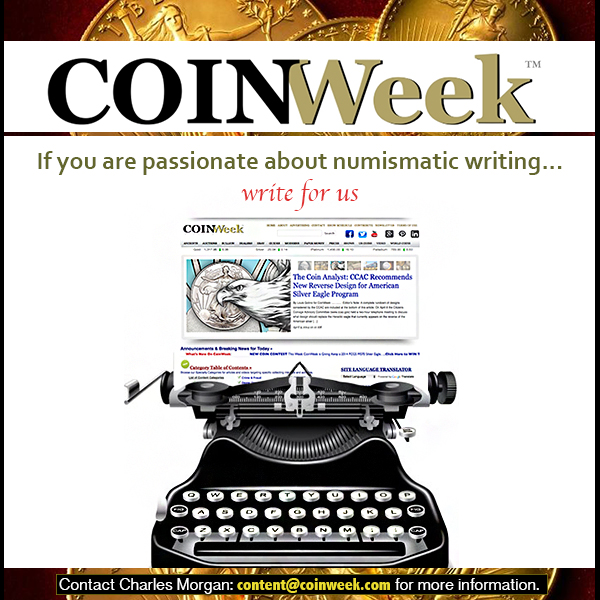
NOTES FROM E-SYLUM READERS: JULY 13, 2014
Dealing With Strong Opinions Greg Burns writes:
Nicely done treatment of the sensibilities within “MORE DEBATE ON LOOTING AND COLLECTING”. Always difficult to deal with strong opinions and personalities. You did a well-balanced job.
To read the earlier E-Sylum article, see: MORE DEBATE ON LOOTING AND COLLECTING (www.coinbooks.org/esylum_v17n28a11.html)
Printsasia Numismatic Book Catalog Online
To view the catalog online, see: www.printsasia.com/NumismaticsMay2014.pdf
To read the earlier E-Sylum article, see: PRINTSASIA NUMISMATIC BOOK CATALOG (www.coinbooks.org/esylum_v17n28a02.html)
Siberian Mintmarks and the Original Russian Spasskiy Roger Burdette writes:
The original Russian edition of Ivan Georgievich Spasskiy’s Russian Monetary System (“Русский монетная система”) has this correct, if memory serves me. The English translation is filled with errors and confusion.
To read the earlier E-Sylum article, see: MORE ON SIBERIAN MINT MARKS (www.coinbooks.org/esylum_v17n28a13.html)
Elizabeth Hahn Benge Leaves the ANS Elizabeth Hahn Benge writes:
Dear E-Sylum Readers:
As some of you may have read in the most recent issue of the ANS Magazine (issue 2, 2014), I have recently left my position as librarian of the Harry W. Bass, Jr. library at the American Numismatic Society in order to move back to my hometown of Chicago primarily to be closer to family.
I wanted to send a short thank you here to all who have made my time working with the numismatic community a memorable and fun experience. I have learned an immense amount about the numismatic field and I have really enjoyed managing the ANS Library. I hope to stay involved in the numismatic community and will continue to serve my post as Vice-President of the NBS through the 2015 term.
Since the ANA is particularly convenient for me now, I hope to attend various events at the World’s Fair of Money in August and will perhaps see many of you there. I look forward to continuing my occasional posts in The E-Sylum and hope that my path will cross with many of you in the future!
Sincerely, Elizabeth Hahn Benge
COINS OF SOUTH AMERICA FROM THE LISSNER COLLECTION
The political and numismatic history of Central and South America begins almost immediately after the discovery of San Salvador by Cristóbal Colón (Christopher Columbus) on 12 October 1492.
Under the terms of the 1494 Treaty of Tordesillas, which divided the newly-discovered lands outside of Europe between Spain and Portugal along an imaginary north-south line 370 leagues (1184 nautical miles) west of the Cape Verde Islands, Spain was to receive sole control over the New World. Because the terms failed to take into account the location of the continent of South America in relation to the boundary line, the tip of what is modern-day Brazil came under Portuguese control. For this reason, while the rest of Central and South America became part of the Spanish Empire and followed the currency system of Spain, Brazil’s coinage is based on that of Portugal. To control all Spanish exploration and colonization, and to collect import duties and taxes of all goods entering Spain, the Casa y Audiencia de Indias, more commonly known as the Casa de Contratación, was established in Seville.
The Spanish colonization of the Americas, sometimes referred to by the Spanish Conquista, involved numerous adventurers, known as conquistadores, and religious missionaries (the Dominicans, Franciscans, and Jesuits), groups that emphasized the primary overseas aims of the Spanish government – conquest of new territory for raw materials, particularly gold and silver, and religious conversion of the local native populations to Christianity (i.e. Roman Catholicism).
...
The New World territories used the Spanish monetary system of the coinage first instituted by Fernando and Isabella in Medina del Campo in 1497, consisting of silver reales (and its multiples and fractions).

MEXICO, Primera República. 1823-1863. AV 4 Escudos.
In 1535, the gold escudo replaced the gold excelente and thenceforth, this became the basis for all the colonial coinage of Spanish America. The discovery of local sources of both gold and silver, particularly the Cerro Rico in Potosí, Bolivia (which provided Spain 41,000 metric tons of silver between 1556 and 1783), necessitated the creation of a number of new mints, not only for local consumption, but also for the export of the quinto real, or crown’s portion, sent back to the Casa de Contratación on the large plate fleets.
The Mexico City mint (established in 1535) was one of the most important of these mints; the other, Potosí (established in 1574), was located at the source of the ore. Later, other mints were established and operated from time to time to handle the discovery and export of the metal.
Until the eighteenth century, hammered coinage was struck. Known as macuquinas, or cobs, these coins became associated with later images of pieces of eight (due to eight reales being cut into pieces for fractions), and pirates on the Spanish Main.
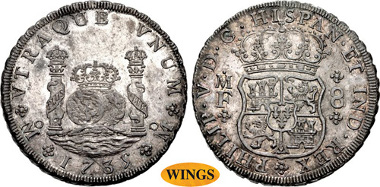
1872: MEXICO, Colonial. Felipe V. King of Spain,
second reign, 1724-1746. AR 8 Reales.
To read the complete article, see: The history of South America told by coins from the Lissner Collection (www.coinsweekly.com/en/The-history-of-South-America-told-by-coins-from-the-Lissner-Collection/8?&id=413&type=a)

LES CITROME ON DIGITIZING A PROFESSIONAL LIBRARY
Regarding the story on the $1 scanning service, Les Citrome writes:
Using my own equipment, I have just finished scanning my professional library of about 1000 or so medical books. I then scanned all my auction catalogs. These were destructive (binding removed) and the paper was then sent on for recycling.
I also scanned about 20 years' worth of the American Philatelist, as part of the volunteer effort to digitize the American Philatelic Society's journal back library.
I have written about my scanning adventures in the attached editorial taken from the International Journal of Clinical Practice, a medical journal published by Wiley-Blackwell and where I serve as Editor-in-Chief.
Everyone needs a book guillotine
 Before feeding hundreds of book pages into a sheet-fed scanner (at speeds of 25–40 pages a minute, both sides imaged simultaneously), you will need to liberate the book from its binding. Inexpensive book guillotines are available for this purpose. For hardcover books, it is recommended you tear the covers off first. The book guillotine will quickly remove the spine of the book in one smooth motion, leaving a stack of paper ready to be scanned. If you desire, you can scan the front of the hardcover on a flatbed scanner later.
Before feeding hundreds of book pages into a sheet-fed scanner (at speeds of 25–40 pages a minute, both sides imaged simultaneously), you will need to liberate the book from its binding. Inexpensive book guillotines are available for this purpose. For hardcover books, it is recommended you tear the covers off first. The book guillotine will quickly remove the spine of the book in one smooth motion, leaving a stack of paper ready to be scanned. If you desire, you can scan the front of the hardcover on a flatbed scanner later.
The scanner
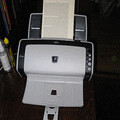 Sheet-fed scanners are commonly available and made by a variety of manufacturers. Basic models allow for 50 sheets to be placed in the hopper, ready to be scanned. Recommended are models that can ultrasonically detect multi-feeds so you can be assured you won't be missing any pages. A higher-end model is illustrated...
Sheet-fed scanners are commonly available and made by a variety of manufacturers. Basic models allow for 50 sheets to be placed in the hopper, ready to be scanned. Recommended are models that can ultrasonically detect multi-feeds so you can be assured you won't be missing any pages. A higher-end model is illustrated...
To read the complete article, see: Preserving books by destroying them: a foray into digitization of a professional library (onlinelibrary.wiley.com/doi/10.1111/ijcp.12316/full)
WAYNE'S NUMISMATIC DIARY: JULY 13, 2014
Tuesday, July 8. 2014 was the monthly meeting of my northern Virginia numismatic social group, Nummis Nova. I arrived early to find some of our members milling about on the sidewalk outside of Sisters Thai in Fairfax, VA. Turns out the restaurant had lost their power and was closed. After some quick re-planning by our host Mike Packard, we soon reconvened a mile down the road at Piero's Corner, a nice Italian restaurant.
Piero's had plenty of parking and a separate room for our noisy crew. The lighting was dim, and wasn't helped by the gathering storm clouds outside. There was a severe thunderstorm warning in effect. But it didn't dampen our spirits or enthusiasm for numismatics.
Besides Mike and myself, attendees included Ron Abler, Ton Kays, Gene Brandenburg, Dave Schenkman, Eric Schena, Steve BIshop, Lenny Goldberg, Roger Burdette, Joe Levine and Jon Radel.
At the recent Baltimore show I'd attended a talk by Rob Galiette and Dave Bowers on their new book on U.S. Liberty Head $20 Double Eagles. Audience members were given a free copy of the book. Since I already had one, Dave suggested giving it to one of my fellow dinner regulars. Great idea! My first order of business was to offer the book to Roger Burdette, and as it turned out, he didn't have a copy of it yet. He does now!
I passed around a few recent acquisitions in numismatic literature, including the latest issue of ANS Magazine and the books on American Red Cross items and WWII Paper Money of Nazi Germany.
I'd also brought an old pocket watch belonging to a friend at work. It had belonged to his father. I had asked Gene to look it over for him and perhaps recommend a repairman. Gene soon had the watch correctly set, ticking, and keeping good time. He showed me how to remove the watch face and find a little hidden knob for setting the time (and I showed my friend's wife when she picked it up from me Wednesday). It may need a slight adjustment, but basically worked. Gene's advice: if it ain't broke don't fix it; and even if it is broke, still don’t fix it. Thanks!
Of course, I need to also thank Gene for generously sharing his red wine. So thanks!
I had no numismatic items to share, but here are a few reports from other attendees, starting with Dave Schenkman, who writes:
In keeping with the patriotic theme, I brought a couple of ad notes.
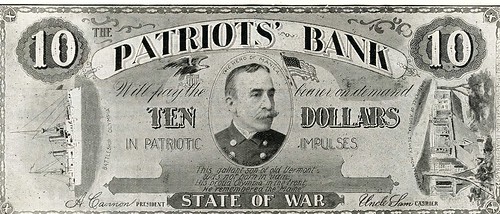
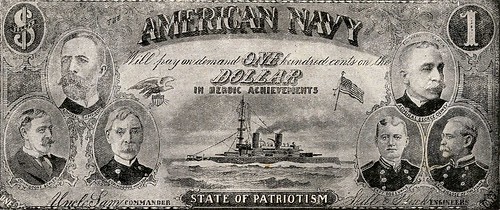
Dave also brought some great tokens. He writes:
Since the meeting theme was patriotic items, I brought a James Wolff, Petersburg, VA token muled with the “Long May It Wave” flag reverse die. I brought the token in five metals: brass, copper, German silver, silver, and tin (white metal) This die combination is rare in any metal; to the best of my knowledge it is unique in silver. The piece came from John Ford, who acquired it with the F.C.C. Boyd collection. The copper one came from George Fuld; I got the other three from Max Schwartz when I purchased his collection of 19th century VA tokens.
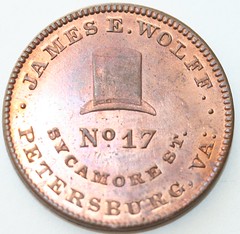
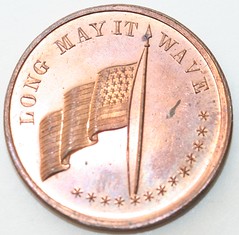
Dave recounted a cute story about how coin deals were made in the Good Old Days:
In 1973, when Max Schwartz and I agreed on a price for his collection of 19th century Virginia tokens, he sent them all to me for inspection and included a letter saying, “now David, we’ve never met and I know nothing about your financial situation, but here’s my offer. You can pay me $25 a month, and if either of us dies before you finish, the debt is considered paid. Then he added, as if an afterthought, “this is an especially good deal for you, David; I’m 75 years old.”
It doesn’t get much more old-school than that!
Eric Schena writes:
While not theme-related strictly speaking, it is a neat piece of local history. I recently picked up a gold medal awarded to the Valley Creamery of Penn Laird in Rockingham County, Virginia for first prize in creamery butter. It was awarded by the Virginia Dairy Products Association at their fair/convention in Alexandria in January 18-19, 1938. The creamery only made butter and eventually had four dairy operations in and around Harrisonburg. It is a rather nifty piece of Americana that I picked up dirt cheap - was all of $30, which isn't bad considering it's 10k gold.
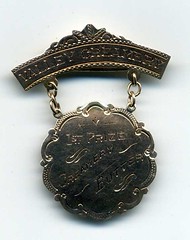

Thanks, guys. It was another great meeting. I wasn't expecting to have much else numismatic to report this week, because I was going on vacation with my family. We left home at 3am Friday to beat traffic out of the Washington, D.C. area. It worked - there was nary a car near us for miles. By 6AM we were already in North Carolina. Our destination was Orlando, Florida, but we broke up the trip with a stop in Savannah, GA.
While in Savannah we decided to try something new. Since our daughter Hannah is in Girl Scouts, we visited the home of Girl Scout Founder Juliette Low. It was an enjoyable tour of a fascinating mansion, and I would recommend it to anyone visiting the area.
In one of the parlors, on display in a bookcase was the Presidential Medal of freedom awarded to Low by President Barack Obama in 2012.
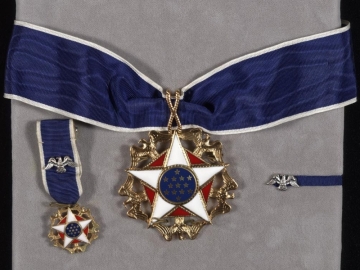
On the way out, I spotted an elongated cent machine, and for 76 cents (three quarters and a shiny new penny), Hannah made a souvenir of her visit to go along with the badge she'd just earned for visiting the home. The visit was the highlight of her day, and our collective vacation was off to a great start.
We arrived in Orlando yesterday afternoon, and hit Universal Studios today. It was great fun, but tiring. Have a great week, everyone.
To read the complete article, see: Girl Scouts Founder Gets Medal Of Freedom (www.gpb.org/news/2012/04/27/girl-scouts-founder-gets-medal-of-freedom)
For more information on the Juliette Gordon Low Birthplace, see: www.juliettegordonlowbirthplace.org/

2014 ANA NUMISMATIC HALL OF FAME INDUCTEES
Ludger Gravel and Vladimir Clain-Stefanelli were inducted into the Numismatic Hall of Fame during the first week of the American Numismatic Association's Summer Seminar.
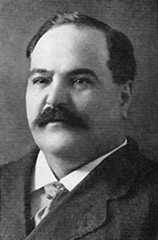 Gravel began collecting coins as a young man. By the mid-1890s, he was an active member and leader of the Numismatic and Antiquarian Society of Montreal in 1895.
Gravel began collecting coins as a young man. By the mid-1890s, he was an active member and leader of the Numismatic and Antiquarian Society of Montreal in 1895.
Joining the ANA in 1908, Gravel helped organize the ANA's 1909 convention in Montreal, the first held outside the United States. He also served as ANA librarian (1910-12), Board member (1921-22), chairman of the ANA's second convention in Montreal (1923), second vice president (1923) and first vice president (1924).
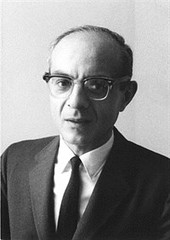 Vladimir Clain-Stefanelli was the curator of the National Numismatic Collection at the Smithsonian Institution's National Museum of American History from 1956 to 1982. During his time there the museum's numismatic collection grew from about 64,000 items to 800,000 items, which included gold coins from the Josiah K. Lilly Collection and Russian pieces from the Willis H. duPont-Georgii Mikhailovich Collection. The Hall of Monetary History and Medallic Art opened in 1964 under Clain-Stefanelli's tutelage.
Vladimir Clain-Stefanelli was the curator of the National Numismatic Collection at the Smithsonian Institution's National Museum of American History from 1956 to 1982. During his time there the museum's numismatic collection grew from about 64,000 items to 800,000 items, which included gold coins from the Josiah K. Lilly Collection and Russian pieces from the Willis H. duPont-Georgii Mikhailovich Collection. The Hall of Monetary History and Medallic Art opened in 1964 under Clain-Stefanelli's tutelage.
Clain-Stefanelli studied archaeology with a specialization in numismatics in Austria and pursued numismatics professionally in Berlin and Rome before coming to the United States in 1951. The ANA recognized him with an honorary membership in 1964.
Induction into the Numismatic Hall of Fame is the ANA's highest honor. The Hall of Fame was the brainchild of Jack W. Ogilvie, a Hollywood film writer and editor who served as ANA historian from 1950-1970. It was created in 1964, and the initial inductees were named in 1969. The Numismatic Hall of Fame Gallery is located at the ANA headquarters in Colorado Springs, Colo. The gallery features photographs and brief biographies of those enshrined.
To read the complete article, see: Gravel, Clain-Stefanelli added to Numismatic Hall of Fame (money.org/communications/press-releases/archives/2014-press-releases/gravel,-clain-stefanelli-added-to-numismatic-hall-of-fame.aspx)
ED MOY ON SAVING BITCOIN FROM THE REGULATORS
 Edmund Moy, the former director of the United States Mint under the Bush administration, first learned about bitcoin in the form of a footnote embedded in a coin demand forecast report.
Edmund Moy, the former director of the United States Mint under the Bush administration, first learned about bitcoin in the form of a footnote embedded in a coin demand forecast report.
When he became director of the Mint in 2006, Moy commissioned annual reports that detailed the various market forces and characteristics that have an impact on coinage needs in the United States. These includes the role of digital payment systems such as credit cards and emerging means of moving money around the internet.
In 2009, the report included a footnote briefly describing Satoshi Nakamoto’s original white paper on bitcoin. At the time, bitcoin and the concept of digital currencies were seen from a curious but hands-off perspective.
During the last two years Moy received the report, the footnote grew slightly in size as the first bitcoins were mined and sold and the price of the digital currency rose. But the Mint – and the rest of the US government – stayed on the lookout for future developments but continued to pursue a largely ambivalent approach.
As Moy told CoinDesk in a new wide-ranging interview, the emergence of new regulations that establish boundaries for how bitcoin will operate within the broader global financial system is one of the key developments shaping digital currencies today.
Despite the promise of bitcoin technology, an unclear regulatory landscape makes it difficult for businesses in the US market to develop. At the heart of the problem, says Moy, is a lack of cohesive regulatory language that defines digital currency.
He said:
“Bitcoin is not just one thing. It’s not just currency, it’s not just a payment system, it’s a protocol – there’s multiple things that cross over into many different turfs of government.”
Moy described the array of federal and state-level agencies as a broad cluster of interconnected agencies, all of whom must act within the framework established by law. Given the novelty of bitcoin and, in some cases, the archaic nature of regulatory language established in past acts of Congress, regulators are left to define digital currency as best they can.
Moy said that each agency can “only look at bitcoin through the prism of what they understand”. Consequently, businesses in the bitcoin space find themselves stuck within the complex legal obstacles that arise from this fragmented regulatory environment and risk failing as a result.
Moy explained that ultimately, bitcoin represents a possible step forward in the debate surrounding the exact definition of money itself. What we’re seeing now, he said, is a broad decentralization of money that the technology underpinning bitcoin has made possible.
Moy said that it’s unlikely bitcoin will replace the US dollar or other fiat currencies directly in the near-term. He argued that digital currencies will co-exist with other currency systems, adding that history demonstrates how diverse mediums of exchange can and often do develop a purpose over time.
To read the complete article, see: Former US Mint Director: How to Save Bitcoin From the Regulators (www.coindesk.com/former-us-mint-director-save-bitcoin-regulators/)
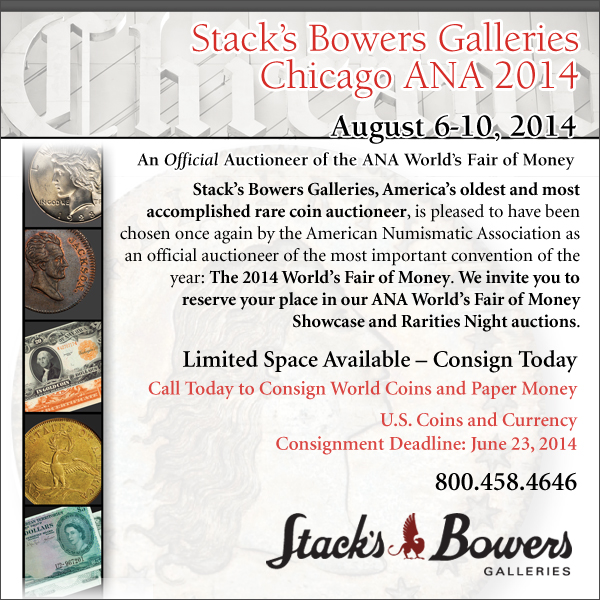
READER OPINIONS ON THE 1863 CSA INGOTS
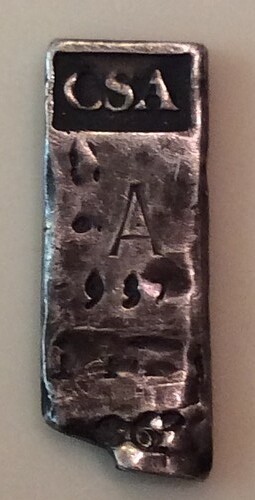
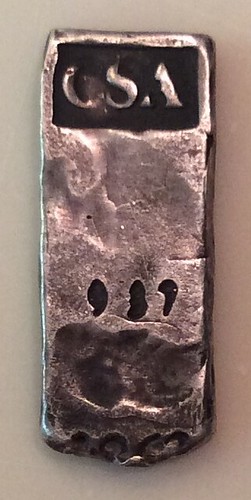
Tom DeLorey, Former Senior Authenticator of the American Numismatic Association writes:
I have never handled any of the alleged CSA silver ingots, but based solely upon the pictures shown, my gut instinct is that they are modern fantasies
Alan V. Weinberg writes:
I personally do not " like" the CSA ingots and discount the excavation story. But I'm going strictly on gut instinct, appearance and experience. There is little reason to believe that these bars are “real”. They possess almost no attributes that would have been present from the period.
Fred Holabird writes:
This subject is very fascinating, and now goes back a few years, coincidently to the time when I was researching the Dahlonega Mint closure while working there for a client. A few months after my digging into archives that hadn’t been seen in decades or more, I received a call from a dealer in Minnesota that had just been offered the earlier CSA ingots. I saw the photos, and immediately had an “opinion” (not positive). The seller, though, was very good at marketing, and soon (a week or 2 later) I got a call from History Channel on them.
I tried to enlist them for a story, because there is a good one here. But ultimately, they weren’t interested in doing a story on fake stuff (my guess). Yes, there was bullion missing from Dahlonega (not little five oz bars), and it never showed up in Milledgeville where it was supposed to go, nor did the people who had it in a wagon.
Highway robbery? Doubtful. Theft by the wagon team? Likely. They disappeared from view……..
To read the earlier E-Sylum article, see: MORE ON 1863 CSA INGOTS (www.coinbooks.org/esylum_v17n28a16.html)
WILL NANOTECHNOLOGY ENABLE PERFECT NUMISMATIC FAKES?
Will nanotechnology develop sufficiently in the future to make it possible to create perfect duplicates that will not be distinguishable from the genuine original coins and paper money?
Nanotechnology is technology on the scale of one billionth of a meter. A cube that measured one nanometer on each side can only hold 176 hydrogen atoms. If you can visualize the size of the Empire State Building as being one meter tall, a nanometer-sized object would be like a marble on the sidewalk next to the building.
Scientists are already able to position individual atoms, though at enormous cost. In the future, technical advances will increase the capability of positioning atoms and molecules at the same time that costs come down by magnitudes. I have a number of friends and acquaintances doing research in nanotechnology. It is impressive how far and how soon this capability is already evolving.
Eventually it will be possible, for instance, to duplicate an 1804 Bust dollar right down to its atomic makeup. Just about anything imaginable could be copied, such as the Series 1890 $1,000 Treasury Note nicknamed the Grand Watermelon, a 1933 $20 Saint-Gaudens double eagle, or a 1974-D aluminum Lincoln cent. The sky is the limit of what could be duplicated to such a degree that even an atomic analysis would not be able to find any difference between an original and its copy.
Following that expansion of technical capability, costs of such perfect reproductions will sooner or later come down to inconsequential amounts. How would the potential widespread and low-cost availability of perfect reproductions of the numismatic items listed above hurt the value of the genuine original pieces?
The issue of producing perfect replicas of rare collectibles is a subject already under discussion among those interested in nanotechnology. Thus far, there is no ideal solution to a problem that is still decades away. There are some collectibles coming out of authentication and grading services today that had bits of DNA (deoxyribonucleic acid) added to them, a security measure that is not currently possible to duplicate. This is a wonderful solution – for now. Eventually, though, future nanotechnology will make it possible to even copy DNA.
Perhaps there will be a way for nano-replicators and nano-assemblers to include “markers” on their output that help identify which machine fabricated a particular item. Such machines might be so complicated that it would be close to impossible for crooks to alter them to not insert such markers. I suspect there will be a never-ending battle between people trying to prevent undetectable reproductions and those seeking to manufacture them. But, that will be a concern to people 50 to 100 years down the road.
There is no need to panic today worrying about how technological advances might hurt numismatic items and other collectibles.
To read the complete article, see: Will perfect copies destroy values? (www.numismaticnews.net/article/news/general/will-perfect-copies-destroy-values)
THE BOOK BAZARRE
JUDGE RULES FOR ODYSSEY SS CENTRAL AMERICA GROUP
A federal judge in Virginia has ruled that a Columbus receivership has salvage rights to treasure from the sunken SS Central America shipwreck, rebuffing an earlier salvage group that claimed it was entitled to the treasure.
U.S. District Judge Rebecca Beach Smith ruled this week that Recovery Limited Partnership, now run by court-appointed receiver Ira O. Kane, is the salvor-in-possession of the Central America wreck.
The ship sank during an 1857 hurricane, and its wreck lies 160 miles off the coast of South Carolina.
The decision means that Recovery Limited has the rights to the treasure it retrieved from the wreck this spring as well as to anything else it recovers.
In March, Kane hired Odyssey Marine Exploration of Tampa to bring up the treasure, which includes tons of gold bars, silver coins and artifacts believed to be worth millions of dollars. The company has been working at the Central America site since then.
The wreck was discovered in the late 1980s by a crew headed by former Battelle scientist Tommy Thompson of Columbus...
Last year, Franklin County Judge Pat Sheeran appointed Kane to oversee Recovery Limited, and salvage efforts resumed after 23 years.
Several members of Thompson’s original team opposed the new salvage effort and filed objections in the Virginia federal court, which had awarded Thompson’s Columbus-America group salvage rights to the shipwreck in the early 1990s.
Under a 1987 agreement between Recovery Limited and Columbus-America, Recovery Limited was the legal owner of the Central America salvage and Columbus-America was the company’s agent.
The Thompson group included former Thompson lawyer Richard T. Robol, former Thompson photographer Milt T. Butterworth Jr., and Mike Lorz, the group’s spokesman.
Following the court decision, I spoke with Milt Butterworth, president of Columbus-America Discovery Group. Here is the brief statement he released then:
“The decision is disappointing. We had hoped to be allowed an opportunity for discovery and a full evidentiary hearing before a decision was made. In the days ahead we’ll be considering options for the future.”
Also attached is a link to the AP story, which I believe you and readers of The E-Sylum will find interesting. Thanks for your continuing commitment to keeping your readers informed.
To read the complete Associated Press article, see: Ohio company wins rights to treasure of 1857 shipwreck embroiled in decades-long legal battle (www.usnews.com/news/science/news/articles/2014/07/10/ohio-company-wins-rights-to-shipwrecks-gold)
To read the complete Columbus Dispatch article, see: Federal judge rules in favor of new SS Central America salvage group (www.dispatch.com/content/stories/local/2014/07/10/Federal-court-rules-on-USS-Central-America-treasure.html)
To read the earlier E-Sylum articles, see:
COLUMBUS-AMERICA GROUP SUES ODYSSEY
(www.coinbooks.org/esylum_v17n21a10.html)
MICHAEL LORZ ON THE SS CENTRAL AMERICA LITIGATION
(www.coinbooks.org/esylum_v17n21a11.html)
ARTICLE HIGHLIGHTS TREASURE SALVAGE FINANCES
Every armchair pirate dreams of finding sunken treasure, but it turns out hauling up chests full of gold bars and pieces of eight is a lousy way to get rich. Recovery usually costs millions of dollars, and even before the loot is on dry land you can look forward to being sued by insurers and other claimants. A few years back Odyssey Marine Exploration OMEX -1.25%, the biggest player in the game, spent $ 2.6 million recovering an estimated $500 million in gold coins from a Spanish shipwreck and then had to give it all back to Spain–plus a $1 million fine. And that’s just one of the misadventure s on our treasure map of misery.
WHYDAH GALLY
A pirate ship ran aground in 1717 and was discovered in 1982. It’s said to have carried treasure worth $400 million. Salvagers have found artifacts like cannons and the ship’s bell but no massive hoard of gold.
REPUBLIC
A steamship sinks in a storm in 1865 and is discovered by Odyssey in 2003. In a rare success, Odyssey has recovered enough gold and silver coins to sell $43 million worth.
NUESTRA SENORA DE ATOCHA
A Spanish ship sunk in 1622 is discovered in the 1970s by adventurer Mel Fisher, who claims it holds $400 million in gold. Historians suspect the number is closer to $20 million. Fisher’s heirs continue to dive the wreck.
SAN JOSE
A salvage company signs a deal with Colombia in 1984 to find a ship supposedly laden with billions of dollars’ worth of Spanish treasure and share the proceeds. After the company claims to locate the vessel, Colombia reneges, insisting on full ownership. The matter remains in litigation 30 years later.
BLACK SWAN
Odyssey announces a discovery in 2007, which it code-names “Black Swan,” and extracts an estimated half-billion dollars’ worth of coins. Spain sues for ownership, saying the ship is a naval frigate sunk in 1804, and wins. Odyssey gets nothing and is ordered to pay Spain $1 million for “bad faith and abusive litigation.”
To read the complete article, see: That Sinking Feeling (www.forbes.com/sites/frederickallen/2014/07/02/the-sinking-feeling/)
THE BOOK BAZARRE
DOVEDALE COIN CAVE FIND REPORTED
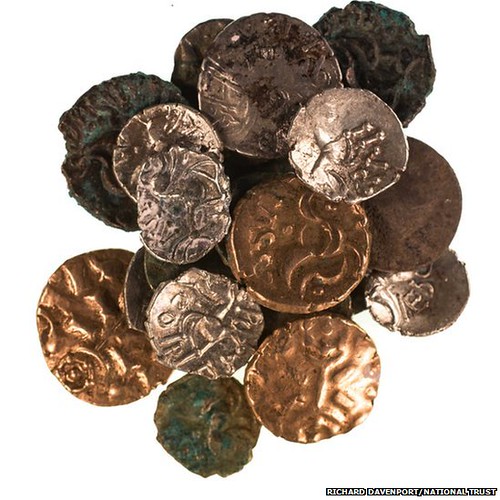
A precious hoard of Roman and Late Iron Age coins has been discovered in a cave where it has lain undisturbed for more than 2,000 years.
The treasure trove was unearthed after a member of the public stumbled across four coins in the cave in Dovedale in Derbyshire's Peak District.
The discovery prompted a full-scale excavation of the site.
Experts say it is the first time coins from these two separate civilisations have been found buried together.
Archaeologists discovered 26 coins, including three Roman coins which pre-date the invasion of Britain in AD43, and 20 other gold and silver pieces which are Late Iron Age and thought to belong to the Corieltavi tribe.
Although Roman coins have often been found in fields, this is understood to be the first time they have been unearthed in a cave.
National Trust archaeologist Rachael Hall said: "The coins would suggest a serious amount of wealth and power of the individual who owned them.
The British Museum's curator of Iron Age and Roman coins Ian Leins said that while this latest find at Reynard's Cave and Kitchen did not quite match the Hallaton discovery, it was "exciting".
For the first time, the National Trust enlisted the help of wounded ex-soldiers returning from Afghanistan to assist with the excavation.
The coins have been cleaned by conservation specialists at the British Museum and University College London and will go on permanent display at Buxton Museum later this year.
To read the complete article, see: Dovedale Roman and Iron Age coins found after 2,000 years (www.bbc.com/news/uk-england-derbyshire-28189287)
ANS LAUNCHES NEW BIOGRAPHIES SITE
The ANS has launched a new biographies site, which contains records for prominent people and organizations related to the ANS. These authority records tie into the new version of Archer, the digital archives of the Society. The former site is built upon xEAC, a system for creating and publishing authority records in the emerging archival data standard, Encoded Archival Context-Persons, Corporate Bodies, and Families. The latter is built upon EADitor, a framework for publishing archival content. Both applications have generated significant interest in the wider library, archive, and museum communities. Biographies are linked to archival resources through linked open data methodologies.
For more information, see: ARCHER | Authorities (numismatics.org/authorities/)
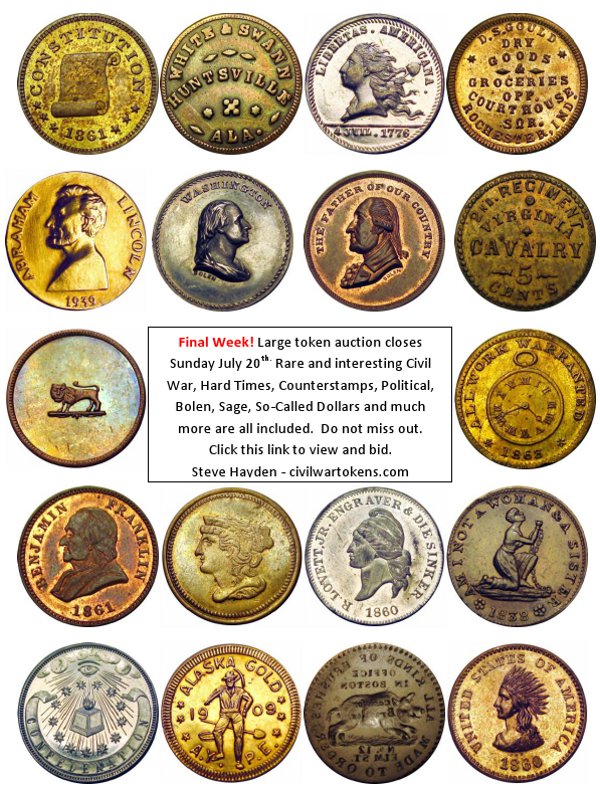
THE DEATH OF THE AUTOGRAPH?
Tom Fort writes:
While not directly bearing upon bibliophiles, this recent article from The New Republic discusses the decline of autograph collecting. Since many of us hold books or other documents signed by noted numismatic scholars, dealers and collectors it might be of some interest.
As you might expect from the author of songs like “Love Story,” “Enchanted,” and “Today was a Fairytale,” the piece Taylor Swift wrote for the Wall Street Journal this week was unashamedly upbeat. She’s optimistic about the future of the music industry (it “is not dying … it's just coming alive”), about the relationship between artists and fans (she compares it to a marriage, and says it’s only made more intimate by social media), even about diminishing album sales (they “challenge and motivate” musicians to push themselves). All of which makes it striking that she has a gloomy outlook on what was once a staple of the music business: the autograph.
“There are a few things I have witnessed becoming obsolete in the past few years, the first being autographs,” she wrote. (She doesn’t say what any of these other “few things” are.) “I haven't been asked for an autograph since the invention of the iPhone with a front-facing camera. The only memento ‘kids these days’ want is a selfie.”
This is not quite true. As Business Week points out, Swift is regularly spotted signing autographs for fans, and she sells signed merchandise on her website. But she may have a point about the decline of the autograph in general.
“It is absolutely true that there’s less demand for autographs,” says Michael Hecht, a financial advisor at Morgan Stanley who, for the past ten years, has also served as president of the Universal Autograph Collectors Club (UACC), one of the largest autograph societies in the world. “There’s a diminishing demand for print journalism. There’s a diminishing demand for stamps. There’s a diminishing demand for autographs.”
Autograph collecting began gaining popularity as an American pastime in the nineteenth century, alongside a growing interest in antiquarianism; among the literate upper classes, elaborate autograph collections, like “cabinets of curiosities,” emerged as markers of status and wealth. A reverend named William Buell Sprague is usually cited as the owner of the first American autograph collection: While working as a live-in tutor at George Washington’s family estate, he asked a nephew if he could keep some of Washington’s signed letters. No one objected when he made off with around 1,500. In the mid-nineteenth century, trendy autograph collectors tried to obtain documents signed by all 56 Signers of the Declaration of Independence. Today, Hecht says, collecting all the presidents is the goal of many ambitious autograph collectors.
Hecht, who has been collecting autographs for 45 years, has watched membership to the UACC—which was founded in 1965—steadily decline during his tenure. Subscriptions to the UACC’s magazine, Pen and Quill, have fallen from a peak of around 2,000 in the year 2000 to 700 today. (Subscribers fork over $29 a year for the quarterly magazine, which publishes articles on how to tell if an autograph is authentic and offers tips on which celebrities don’t mind being approached for autographs.) When I asked Hecht about the demographics of his club, he answered in one word: “Old.” Autograph collectors also seem to be overwhelmingly male: Eight of the nine staff members of UACC are men.
Hecht believes Swift is right to pin part of the blame on the rise of selfies. “As we become more and more of a visual society, people want a visual representation of their favorite stars. We don't know them through their writing, through their letters; we know them by their faces.”
To read the complete article, see: Taylor Swift May be Right About the Death of the Autograph (www.newrepublic.com/article/118669/taylor-swift-thinks-selfies-will-replace-autographs-so-do-collectors)
RUSSIAN LAWMAKER WANTS APOLLO'S GENITALS REMOVED
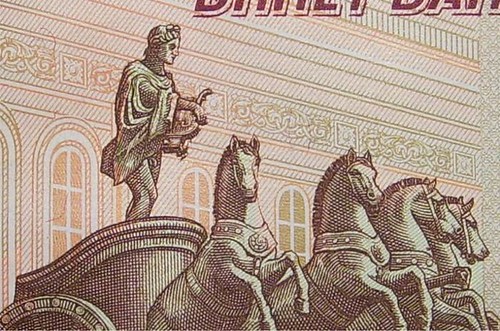
Roman Khudyakov, a member of parliament for the nationalist LDPR party, submitted a parliamentary request to remove the image of Apollo from the 100 ruble banknote, worth just under $3. The note shows Apollo riding a horse-drawn chariot standing atop the Bolshoi Theater.
"You can see clearly that Apollo is naked, you can see his genitalia," Khudyakov told Reuters Television. "I submitted a parliamentary request and forwarded it directly to the head of the central bank asking for the banknote to be brought into line with the law protecting children and to remove this Apollo."
According to Khudyakov, the penis in question is in danger of harming children. "The girl screamed at the boy: 'Can you see that? I told you, there is a penis here!' I was shocked, you know,” he told Reuters Television.
The Internet, naturally, ridiculed the Russian lawmaker's request. Some even went as far as claiming Khudyakov was concerned kids would see Apollo’s genitals and “turn gay.” Lest we forget that Apollo had many gay lovers in his time.
To read the complete article, see: Russian Lawmaker Wants Apollo's Genitals Removed From Hundred-Ruble Banknote (www.ibtimes.com/russian-lawmaker-wants-apollos-genitals-removed-hundred-ruble-banknote-1623836)
THE BOOK BAZARRE
FEATURED WEB PAGE: BYRON REED COLLECTION
This week's Featured Web Page is suggested by John and Nancy Wilson, who write:
In March we cut out a Coin World article regarding a Guest Commentary by Carrie J. Wieners who is the Curator of Exhibits and Collections at the Durham Museum in Omaha, NE. This museum houses the Byron Reed Collection. Today we went on the site that contains the Reed Collection. It is located at www.DurhamMuseum.org
On the site you will find the Reed collection. All you have to do sign-in and you can view this fantastic collection. In the Coin World Guest Commentary article it depicts a .75 "unique" Republic of Texas note. Many different numismatic items will be found in this collection. They welcome visitors to this site, as well as donations and an application to join.
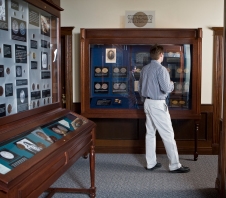
www.DurhamMuseum.org
